Use the following link to download the February 14, 2024 issue of the syəcəb
Category: Tulalip News
Operation Heart to Heart
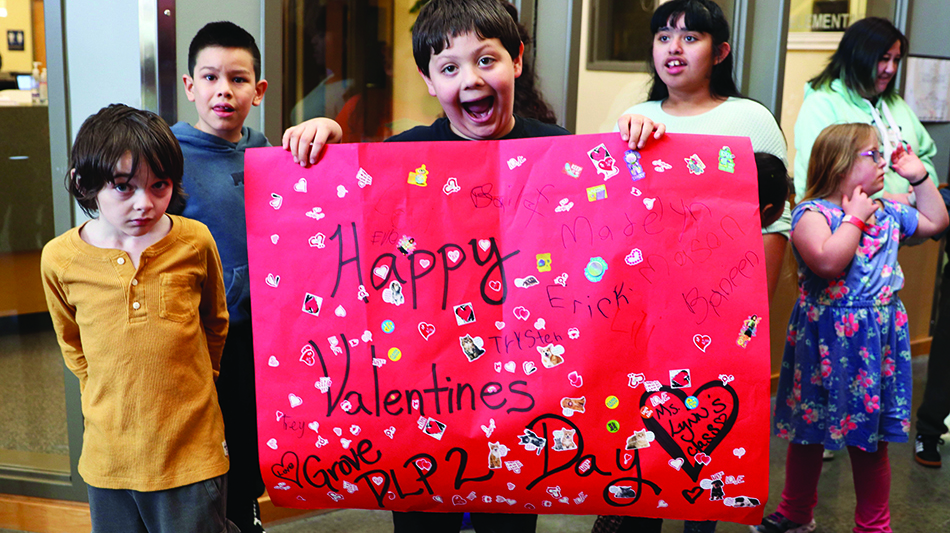
By Kalvin Valdillez, Tulalip News
In celebration of Valentine’s Day, 15 high school students of the Marysville School District (MSD) organized a beautiful and heartwarming event that brought endless smiles to special needs students across the district.
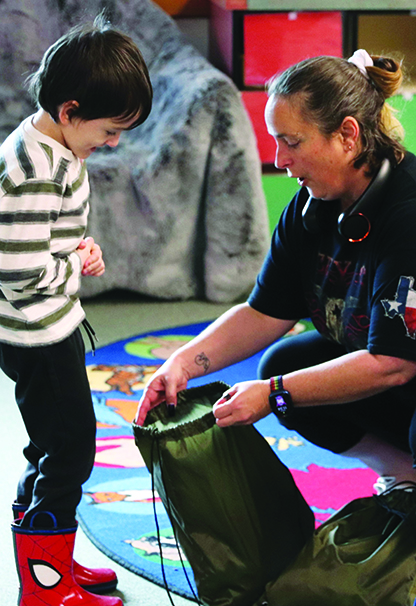
Officially dubbed Operation Heart to Heart, the event originally made its debut three years ago and was organized entirely by the Marysville Getchell Native American and Friends Club. The club planned the first gift giving event to spread love and kindness to developmental learning program (DLP) classrooms within MSD, and it’s grown every year since.
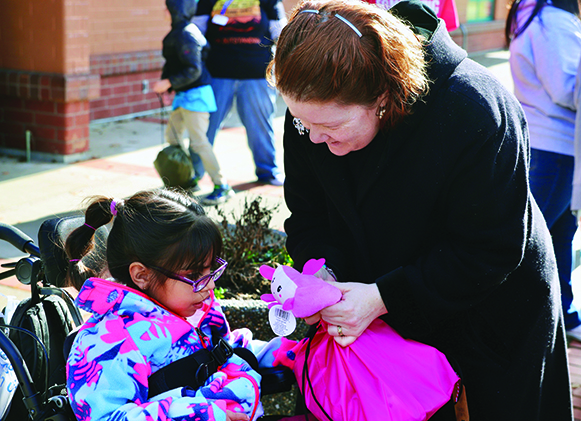
This year the Marysville Pilchuck United Native Club joined-in on Operation Heart to Heart. The two clubs also partnered with Leah’s Dream Foundation and the Tulalip Tribes, both of which made contributions to the project. Additionally, the clubs released a flyer at the top of the year which asked the community for donations of coloring books, crayons, fidgets, colored pencils, stickers, stuffed animals, and small toys. The club members then assembled gift bags to distribute to several schools throughout the district in the few weeks leading up to the annual event.
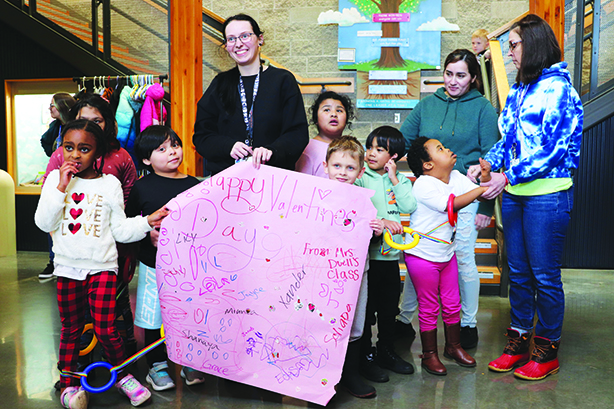
Said Charley Dick, President of the MG Native American and Friends Club, “Today we delivered all the Operation Heart to Heart donations, which was really heartwarming. It’s nice to be able to go see everyone and to just see all the smiles on everyone’s faces. It really makes me feel like our club is doing good things and like we are positively affecting the community, because we’re all about inclusion, building community, and making a good impact.”
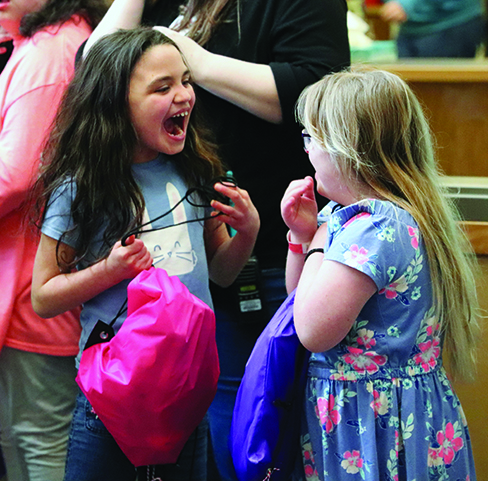
Operation Heart to Heart 2024 kicked-off on the morning of February 13, at Quil Ceda Tulalip. In a classroom of just four students, as the new DLP is still in its infancy stage, the two clubs presented the first gift bags of the holiday season. The clubs, along with a handful of MSD Native liaisons, then offered a traditional song to the students before saying their farewells and continuing on their journey.
In total, the clubs visited seven schools, four elementary schools, two middle school schools, and one high school over a two-hour span. Getchell’s 18-21 special needs teacher, Jim Strickland joined the excursion at the second stop and brought out his acoustic guitar to sing ‘You Are My Sunshine’ to the DLP students while the club members distributed the gift bags.
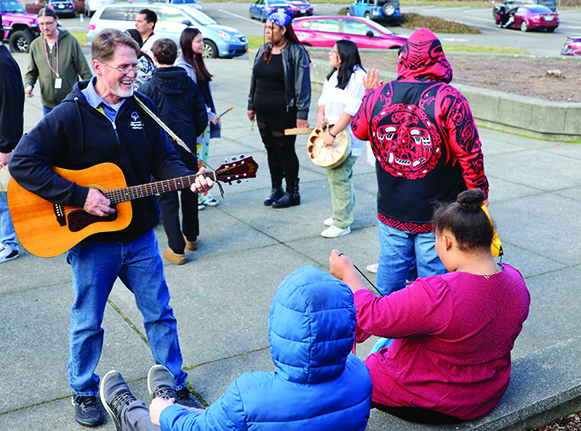
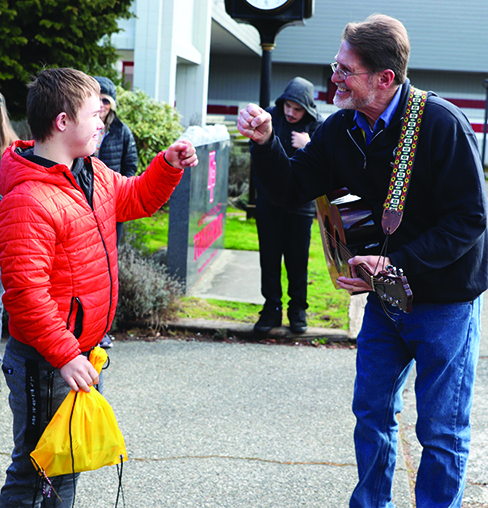
The clubs were met with warm welcome at each of the seven campuses, some classrooms even made posters and valentine’s cards for the high schoolers in anticipation of their arrival. And though the amount of time the clubs spent at each school was brief, there was still plenty of laughter, dancing, hugs, smiles, and warm fuzzies to go around during the Valentine’s Day event.
Amy Sheldon, MSD Special Education Native American liaison, expressed an overall excitement to see inclusivity celebrated by students in today’s school system. All throughout the Heart to Heart event, Amy beamed with pride as she watched the club members interact with the students at each and every school.

Amy shared, “I think the important thing is for our students to realize that they’re making a difference by including others, and understanding, and being accepting of others. I’m really proud of what they’ve accomplished, and they’re really enjoying what they’re doing. My favorite part of the day was seeing the smiles on everyone’s faces. I want all special needs kids to feel like they’re part of something in our schools – and I’m really happy that our students [in the clubs] are stepping up.”
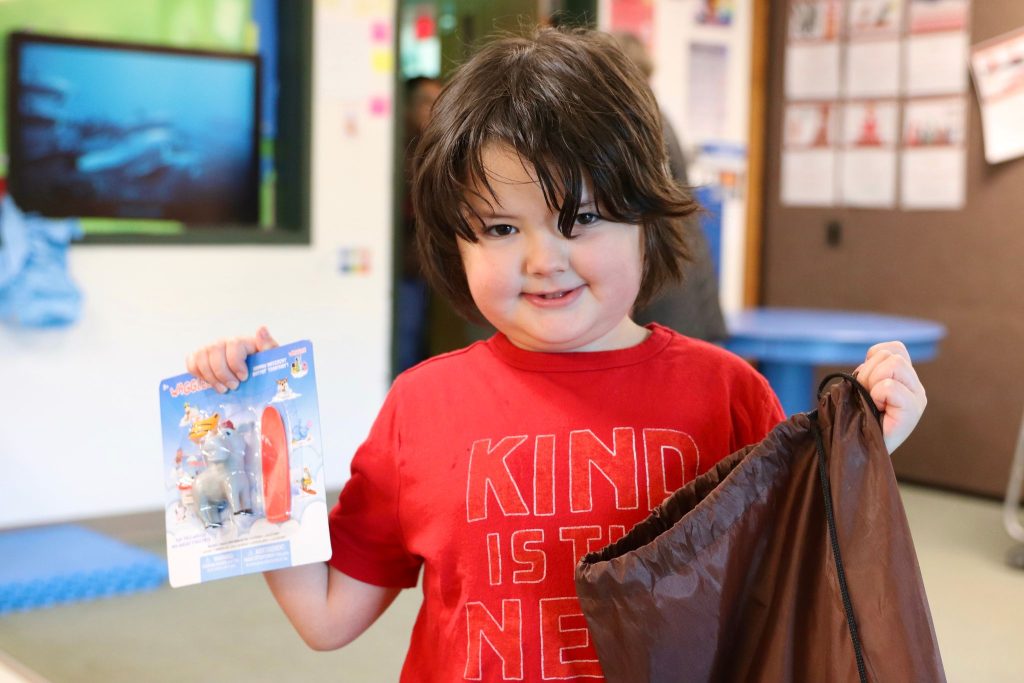
After making their rounds at Quil Ceda Tulalip elementary, Marshall elementary, Marysville Pilchuck high school, Cedarcrest middle school, Kellogg Marsh elementary, and Grove elementary, Operation Heart to Heart concluded at Totem middle school. Following the distribution and song offering, the two clubs elected to take one big group picture together. And with the success of today’s event, the groups expressed a desire to work on future endeavors together, in addition to supporting each other’s upcoming projects.
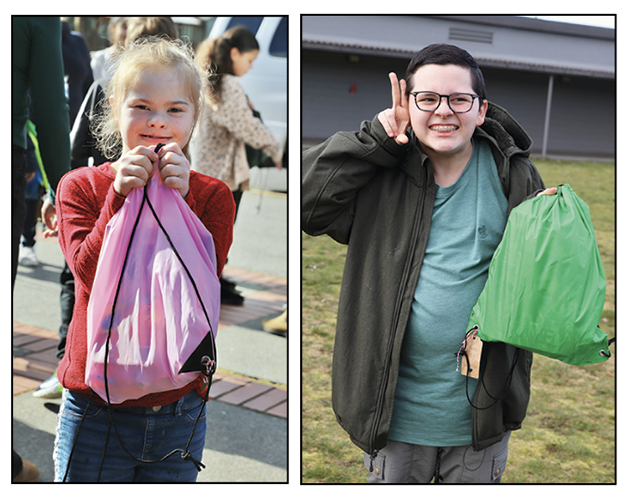
“This is really important to me, because I just want to make sure that everyone feels included,” expressed Charley. “It’s really nice to know that we’re making a lot of these kids’ days. It’s important to let them know that they have a community, that they have people who care about them, because a lot of students do face bullying. Knowing that they’re included in activities like these, and knowing that when they do go to middle school and high school, that they have people who are there for them and who will give them that safe space is important.”
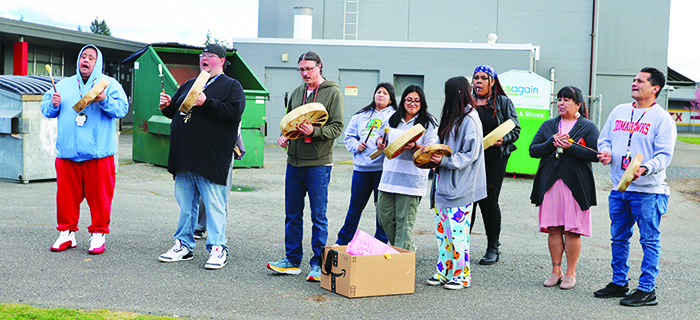
Both of the clubs will continue to host events and activities throughout the school year. Be sure to follow the MG Native American and Friends Club and the Marysville Pilchuck High School Facebook pages for more information.
Dr. Karen Foster-Schubert joins Tulalip Health Clinic
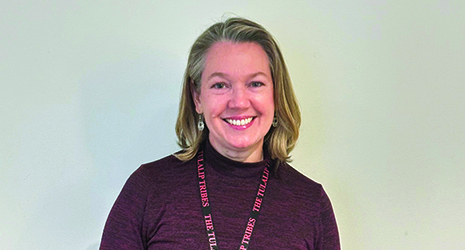
By Wade Sheldon, Tulalip News
On December 18, Dr. Karen Foster-Schubert, a seasoned medical professional with a rich background, has assumed the crucial role of the new medical director for the Tulalip Health Clinic. With roots in Seattle and a long career with the University of Washington Veterans Affairs (V.A.), Dr. Foster-Schubert brings a wealth of experience to shape the future of healthcare delivery for the Tulalip community. Emphasizing the collaborative approach needed for success, she notes, “There is so much to learn and many decisions to make going forward.”
Karen achieved her medical degree from Johns Hopkins University School of Medicine in Baltimore, Maryland, and did her internal residency in San Francisco. Then, she returned to the Pacific Northwest to finish her fellowship at the University of Washington before becoming a faculty member at the VA.
While immersed in roles at the V.A., Dr. Foster-Schubert found herself at the nexus of administrative leadership with an unwavering commitment to improving healthcare systems. Little did she anticipate that her extensive background, including spearheading the endocrinology department and serving as the Vice Chief of Medicine, would draw the attention of Jeremy Howell, the Health System Administrator for Tulalip.
“I knew Jeremy from the V.A. and several specialty care work,” Karen said. “So when he reached out, I was like, this seems like a good opportunity to work with some amazing people, make a difference in how the healthcare system is organized, and bring in some specialty care. I am an endocrinologist, so I do a lot of work with diabetes and metabolic disease.”
Dr. Foster-Schubert’s decision to embark on this new chapter stemmed from a desire to make a tangible impact. Moving away from the expansive yet bureaucratic V.A. environment, she sought a more hands-on role where her insights could directly influence positive change. The pressing goal for Tulalip became clear – accreditation, which is a review process to determine if programs meet official regulatory requirements and standards of quality

“One of our biggest goals is accreditation,” Karen explained. “The accreditation process helps ensure a safety and healthcare excellence culture and improves access and equity. We have a consulting team to help look at every aspect that needs to be addressed to become accredited.”
Karen continued, “Another goal would be to focus on a culture of respect. That means that we all need to respect one another, respect everyone’s rules, and have a good understanding of everyone’s rules. This is not only for our staff and providers but also for our patients so that we are treating our patients with respect and, in return, creating a better sense of trust.”
As the tribe endeavors toward accreditation, Dr. Foster-Schubert lays out the multifaceted approach necessary for success. Addressing fundamental aspects such as the healthcare environment, safety protocols, and infection prevention systems, the tribe aims to overhaul its primary care system.
While acknowledging the enormity of the accreditation process, Dr. Foster-Schubert views it as an opportunity for constructive change. She envisions a roadmap that aligns with Tulalip’s goals, emphasizing that accreditation isn’t a sign of past shortcomings but a collective journey toward more efficient and effective healthcare delivery. The tribe’s investment in training, particularly launching the patient-centered medical home (PCMH) process, underscores the commitment to coordinated care and continuous improvement.
“This is a little bit of a learning process for me,” Karen said. “I’m trying to understand how this system focuses on primary care delivery. I’m particularly concerned with ensuring efficient communication within our system and with external referrals. Since we can’t offer every specialty care in-house, it’s crucial to streamline the process for a seamless experience. We want to make it so that when we can’t provide the care in-house, and when they travel outside our health system to get the care they need, they know they have our support and understanding of navigating the health care system.”
Dr. Foster-Schubert concluded with a focus on change management and the importance of transparency and engaging tribal members in the process. “Change can be scary, and I want to do that in a way where everyone is engaged and excited. Be willing to be transparent; our tribal members must hear people’s voices around what perceived gaps we have and what needs aren’t being met.”
February 10, 2024 syəcəb
Use the following link to download the February 10, 2024 issue of the syəcəb
Mix Master Monie: Beauty in the beats and in the breakdown

By Kalvin Valdillez, Tulalip News
“One of the primary joys I get from DJing comes from knowing that I can bring people out of what they’re going through,” expressed Tulalip Disc Jockey, Monie Ordonia. “If they’re worried or stressed, they can come and get lost in the music. They can release and be in the now moment, and not think about the later, because when you’re dancing, you’re not thinking about any of that.”
Like many Native American musicians, Monie has a special relationship to the rhythm, bassline, and drum beats. Traditionally, Natives are brought up with a deep respect and love for music as certain songs and chants are held in high regard and are only brought out for special occasions. This practice is embedded in the DNA of countless tribal members. Over the years, music has served as good medicine that has helped many through heartbreak, grief, and battles with addiction. On the flipside, music has also amplified the joyous times, and people often tie happy memories to songs of that specific moment in time.
DJ Monie developed a strong connection, a thorough understanding, and an undying passion for music at a young age. Growing up off-reservation, in the central district of Seattle, Monie’s appreciation and respect for music has always been on par with her ancestral ways.
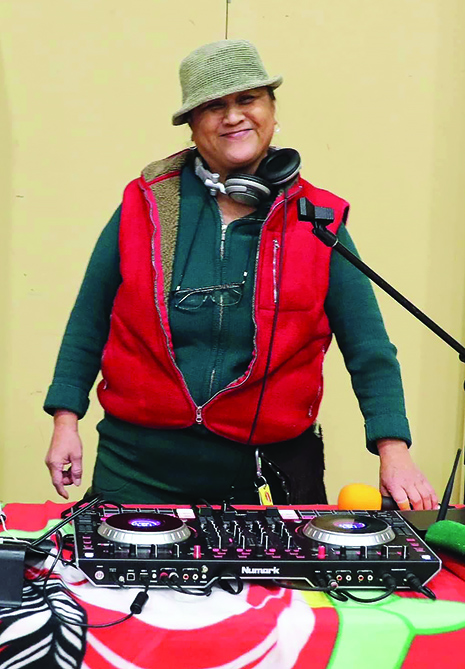
Even though she had yet to be introduced to the traditional songs of the sduhubš, the sheer knowledge that music is sacred medicine was something that she cued in on early in her journey. And coming from a line of healers and medicine men, Monie found a way to use this particular medium of beats and breaks in such fashion when she found her home behind the turntables in the early 90’s.
“It’s all about beats,” she exclaimed. “Beats are the biggest thing for DJs. I am self-taught, for the most part, because I can hear beat patterns when I listen to music. Because I know what other song would flow with it, I could be like ‘oh, that part would work really good with that song.”
She continued, “Growing up in the hood, I grew up with a lot of black folk, so I listened to a lot of R&B and Motown in the 70s. And of course, my older sisters, Esther and Muffy, were a huge influence. They loved music. When we would go buy gifts for each other, the majority of the time we ended up at the record store. In the late 70s, I was into Earth, Wind & Fire, The Commodores, Cameo – all those big musician groups where they all played real instruments, that was a huge influence on me.”
While attending Garfield High School, Monie chased her passion and joined the school’s band program. She set out to master the piano, and with natural talent and a great ear, she was content with learning just enough to get by in class. The temptation of a thrilling adolescence was too strong, and she put off learning how to read music in favor of a fun teenage social life. But her escapade with music was far from over.
During this time and through her early college years, Monie perfected the technique of curating playlists, a skill that would come in handy when she found herself in the DJ booth a few years down the line. Now keep in mind, this is the 80s, a time before mixtapes were popularized and cut together on the regular by the masses. After relocating to downtown Los Angeles in 1984 and running with a crowd of USC students, Monie started receiving numerous requests for her tapes. She dedicated time to creating the perfect mixes for her group of friends and the parties they would host. That was until 1989, when she decided to take the next step in her journey with music and invested in some professional equipment.
“One day, one of my buddies said we should have a party. And I was like, ‘I’ll go get a mixer and some turntables and play the music for the party,” recalled Monie. “I bought this Gemini mixer for like $70, it had all these little sound effects and everything on it. Next, I bought turntables for around $60, you could change the speed on it, but they were still belt driven. And last, I bought some headphones, and I started practicing.

“I had a couple of friends that already had some DJ experience. One of my friends from Compton taught me a trick on how to rig my turntables, so I wouldn’t burn my motor out while trying to rotate the vinyl backwards or scratch, so it would slip really easy. Once I learned how to do that, I started spinning it back and holding the vinyl to where I could find the beat, to drop it right into the other song. I practiced that a lot and started getting really good at mixing and blending.”
Monie shared that her decision to purchase equipment and DJ her friend’s party ultimately led to more opportunities. The same friend that suggested they should host that party put Monie on game when a resident DJ at a local club announced she would be leaving her post for other endeavors.
Now, this wasn’t just an average run-of-the-mill club. No, this was the historic Jewel’s Catch One Disco Club, one of the first black discos in the US, and officially the longest running black gay bar in LA. In its heyday, Catch One hosted live performances from the likes of Whitney Houston, Luther Vandross, Janet Jackson, Rick James, Madonna, and Tulalip’s own DJ Monie.

With some encouragement from her friend, Monie earned a residency at Catch One following a killer audition that left the club owner stunned. She started DJing regularly during the club’s weekly Ladies Night event on Thursdays, as well as during Friday’s Happy Hour spot at their downstairs bar.
At a time where music genres hardly ever clashed, when house was house, grunge was grunge, hip-hop was hip-hop, and R&B was R&B, Monie dared to blend, which brought people to the dancefloor in droves.
“That feeling – there’s nothing like it,” she exclaimed. “When a dancefloor is going crazy, that’s my high. I was different from all the other DJs because I would move in between genres. I’d play the popular R&B and hip-hop at the time, but then I’d mix in stuff from the 70s and 80s that I had in vinyl collection. Whenever my sister would get rid of her music, she gave me her vinyl records, so I had built a huge collection over the years. When I mixed in the old school – Prince, Cameo, Teena Marie, – the response I would get was crazy. The crowd would put their arms in the air, they’d be screaming and dancing crazy. That to me is the biggest compliment.”
Monie quickly built a name for herself, and the dancefloor would be packed each time she was on the ones and twos. She found herself in popular demand and was so well-known that she added additional sets throughout the weekends to appease frequent club-goers, while still maintaining a full-time printing job during the day. She became more comfortable and confident during her sets and perfected her craft by means of real-time experience.
DJ Monie put in four-years at Jewel’s Catch One before the gig began to lose a bit of its luster, before the dream began to feel more like a job where she was getting underpaid for her work. When this happened, Monie was also doing some personal healing following a breakup. For these reasons, she decided to take a step away from the booth and focus on her wellbeing. During this time period, which turned out to be a one-year hiatus, Monie’s presence was missed by many. Whenever she was recognized in public or caught unwinding at a nearby club, she would leave many disappointed once they found out she would not be performing a set that night.
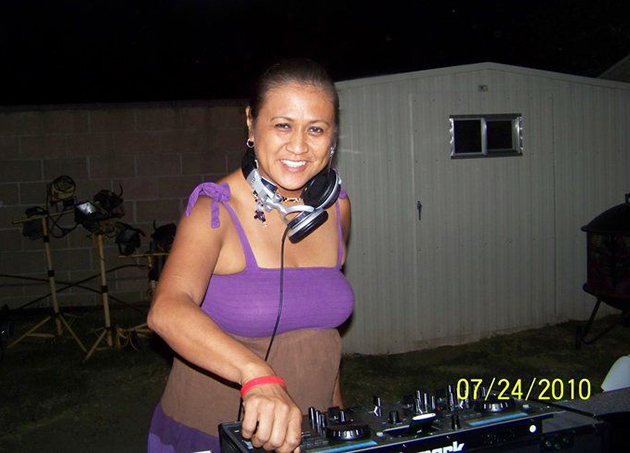
This made her return to the game even sweeter for the 90’s LA club scene. Although, this time around she decided not work the clubs at all. It was by her roommate’s request that Monie found herself once again comfortable inside her sacred space – behind a mixer and a set of turntables. Upon agreeing to DJ her roommate’s backyard birthday party, the word spread like wildfire. On the night of the party, over 400 people were in attendance and the line to get into the party stretched around the block. Amongst all these attendees were some big-name celebrities such as MC Lyte, Meshell Ndegeocello, Teena Marie, as well as women’s basketball legend and Monie’s personal friend, Cheryl Miller.
“I didn’t even get to see Meshell Ndegeocello because the place was so full,” shared Monie. “I was DJing from the back bedroom, looking through the windows out to everybody in the backyard. And that’s how I started my revitalization with DJing. That party lasted ‘til five in the morning. After that, I made everybody breakfast and my friends were still hyped up about it. So, I decided to start throwing parties. I spaced them out two or three months apart, so people would anticipate it and get excited. I averaged 300 people per party. After about a year-and-a-half, people started hiring me to DJ at their gigs. I was even throwing yacht parties at the marina. It was awesome. Those were some good times.”
DJ Monie’s sets were so epic that she once received one of the funniest requests of all time. She shared, “There was a party for one of my buddies. I was there spinning away, and everybody packed the dancefloor and was having a good time. I had someone come over and she was dancing right by me on the floor, because there wasn’t a booth set up there, we just had tables. She came over was like ‘honey can you play a messed-up song?’ And I asked, why do you want me to do that? And she said, ‘I’ve been on the dancefloor for the last six songs, and I can’t get off the dancefloor because you’re jamming too much. Play something whack!’”
Cracking up at the memory, Monie continued, “I never heard a request like that in my life. It blew my mind when she said that. I told her I couldn’t play something whack, but I’d slow it down a bit so she could make her way off the floor.”

Monie would go on to have a long and fruitful career as a LA DJ, one of few women DJs in the area. Throughout the 80s and 90s, Monie’s mother, Janice Wyakes, also lived in the greater Los Angeles area. However, Janice would return to Tulalip in the late 90s following a family reunification when they got in touch with Monie’s sister, who was adopted at a young age. When the time came for Monie to return to LA, it was decided that it would be in Janice’s best interest, health wise, to stay in Washington under the care of Monie’s sisters.
A few months after celebrating her 75th birthday, Janice made her transition to her next journey in March of 2012. It was at this point when Monie began to contemplate moving home to Tulalip.
Said Monie, “I loved LA. I had been there for like 28 years. But when my mom passed away, the energy shifted so strong. I knew that I would be moving back here. And around the time when my mom passed away, my sister Muffy just started doing chemo for cancer. So, it was time for me to come back.”
Monie mentioned that she felt an energy shift. Now many of you who know Monie, also know that she is intuitive as heck. The universe did in fact begin to work its magic, preparing Monie for a return to her ancestral homelands. In phase one, Monie was laid off from her printing job, and since she was eligible for unemployment, she was able to save up for a possible move. On her sister’s advice, Monie put her name on the list for tribal housing. Phase two kicked off with a phone call, which informed Monie that a house became available on the reservation and was move-in ready.
She would soon discover that her new home was on a hill overlooking her sister’s neighborhood, which was the icing on the cake. In the summer of 2014, Monie’s permanent address officially included a 98271 zip code. But by her standards, Monie initially kept a low profile in her first few years back at Tulalip, as her sole focus was spending time and caring for her sister throughout her battle with cancer. When Muffy made her journey to the afterlife, Monie found comfort and support in her community.
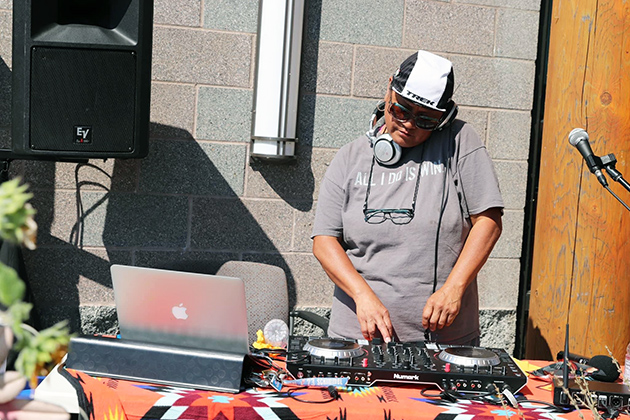
“The first couple years, I had to get acclimated to the change in weather, and because LA is a big city, I had to get used to it being so quiet except for when they have coastal jams or longhouse stuff,” she stated. “I remember the first time I ever experienced the longhouse, but it was not literally down at the longhouse. I was here at home; it was summertime in the evening. I thought who the hell is doing construction work at this time? I called my sister Muffy like, ‘who’s doing all that banging outside?’. So, she went outside, and I could see her in her driveway listening. Then she looked at me while still on the phone, and she said, ‘oh that’s the longhouse!’. I never heard that in my life. So, it took me awhile to adapt from city life to rez life.”
In her past 10 years of residency on the rez, Monie made strong efforts to be there for her people, especially when it matters most. Whether you were introduced to her at a cultural gathering, community event, on the frontlines at local rallies tackling social injustice issues, or perhaps at one of her art classes for community members in recovery, Monie has become a source of good energy, and many find themselves gravitating toward her for stimulating conversation and a hearty laugh.
Somewhere along the lines, word got out that Monie was nice on a set of turntables. Over the past few years, the local dances and community-wide celebrations have been slappin’ thanks to her music expertise. Event goers already know that it’s going to be a smash if they’re able to spot Monie and her signature setup of her MacBook Pro and her Numark digital DJ controller at the function. Her personality bleeds into her performances and her good vibes are contagious whenever she’s in her DJ element.
“Honestly, when I first started DJing events here I started questioning if Tulalip people actually dance. Because I noticed that people would bob their heads and say they loved the music, but nobody was dancing. And being a club DJ, packing the dancefloor, and having people requesting a whack song so they can get off the dancefloor, that’s what I was normally accustomed to. But one of the most fun parties I worked is when I DJed the Valentines Day party last year. People were dancing at that one. And you know anytime people are dancing, that’s what make me happy. It lets me know that I’m doing my job.”
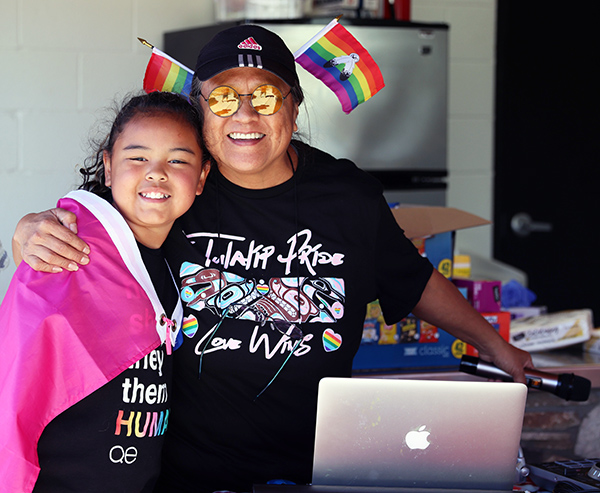
You can catch DJ Monie spinning at the upcoming 477/TANF and Child Support program’s Valentine’s Day Social from 4:00 p.m. – 7:00 p.m. at the Greg Williams Court.
Monie has also expressed a desire to share her knowledge with any youth interested in learning about the art of DJing. When asked if she had any words of advice for young aspiring DJs, she shared that it’s important to take pride in your work and invest in yourself.
She expressed, “I take pride in my reputation as a DJ, because I know that’s one of my professions. I take it very seriously. I started with vinyl. Now, with digital controllers it’s a lot easier, everything’s at your fingertips. Pay attention to your crowd and play the music they want to hear, not the music you want to play. And start training your ear and listen to other DJs because there are different techniques going on from one song to the other. Listen to mixes – how people blend, the different beat drops, the backspin to transition to a new song. I also think it’s important to use your money to invest in yourself. And for me, my DJ equipment was investing in my joy that feeds not only my soul, but also sustains my livelihood.”
Be sure to check out DJ Monie’s playlist that she curated to highlight her career as a renowned Indigenous DJ. Add the tracks to a playlist on your Spotify, YouTube, or Apple Music accounts and be sure to hit play whenever you need a good dance session or a pick-me-up.
_____________________________________
Monie’s Grooves
Curated by DJ Monie, this playlist is packed with feel good beats that are sure to get the party started! Each track also follows Monie’s journey as a DJ, from her early years collecting vinyl to her favorite jams of today!
70s
Play That Funky Music – Wild Cherry
Good Times – Chic
Bounce, Skate, Rock, Roll – Vaughn Mason & Crew
80s
Candy – Cameo
Another One Bites The Dust – Queen
90s
The Power – Snap
Poison – Bell, Biv, DeVoe
2000s
It Takes Two – Rob Base
Present Day
About Damn Time – Lizzo
Break My Soul – Beyoncé
Christopher Gobin takes on new role as Deputy Chief

By Wade Sheldon, Tulalip News
Newly appointed Deputy Chief Christopher Gobin, a dedicated officer with 17 years of service with the Tulalip Police Department, said, “I had a negative experience with a state game warden when I was younger, and it left a bad taste in my mouth, and I didn’t want our tribal members to deal with people that don’t care.” This poignant experience served as a catalyst, propelling Gobin toward a career in law enforcement where honesty, fairness, and a deep connection to his tribal community would become the guiding principles of his service.
Said Christopher, “I felt honored when I was asked to be Deputy Chief. It sets an example for younger tribal members: I don’t have a college education, but I can still achieve a high leadership role with hard work and dedication. I went to the Army and came back and have been a police officer for the tribe ever since. I’ve worked my way up, and it shows these younger tribal members that they can achieve high levels of leadership in our tribe. It’s a lot more paperwork than out on the streets. Still, it’s an honor to put my fingerprints on the department, bring my knowledge of what the community has told me they need, and, as a community member, know where this department should be going.
I have a better understanding of what the tribe needs. It’s not someone outside the tribe trying to dictate what the tribe needs. I can listen to the community members; they trust me. So, I can coordinate with the police department and help the community get what it wants out of the police department.”
“The drug epidemic with fentanyl is probably an everyday thing with us,” Christopher explained. “It’s not only the crime that’s associated with people that are lost in addiction; it’s dealing with the mental health side of things also.” Gobin details the efforts to combat this: “We have bolstered our drug task force; five members are in it now. Every day, they are getting drugs off the street. Even one little pill can kill someone. So, if we can get one pill off the street, that’s one less chance of a tribal member dying.”
Looking ahead, Gobin outlines his goals, acknowledging the challenges faced by the police department: “Address the staffing issues; there’s so much more that we could be doing if we had the staff. Also, better training, with dedicated workers that spend 24/7 on the job and insufficient staff to take their place, makes it difficult to get extra training that is well needed.”
Building deeper bonds within the community is a crucial objective: “Getting the community know the police officers and see them as not just the police but also as people. This community does a good job of embracing our officers; I want to further that. It makes the community safer, and it makes the job safer.”
Recruitment of tribal members into the police department is a priority for Gobin: “My last goal would be to recruit tribal members to join the police department. It has been tough to get tribal members to work here. Building the police department with community members working and living in the community so they have that closer tie helps keep officers here. It builds the next generation of leaders.”
Christopher is an excellent example of how hard work, dedication, and a passion for the job can bring you to new heights and bring new opportunities to your life.
Christopher said, “Every day, I am going to try and do the best I can with my tools, and I will strive to make this a better police department. I want Tulalip to be where establishments like Marysville and Everett go. That’s what a police department should be.”
Lady Hawks season ends with near miracle comeback
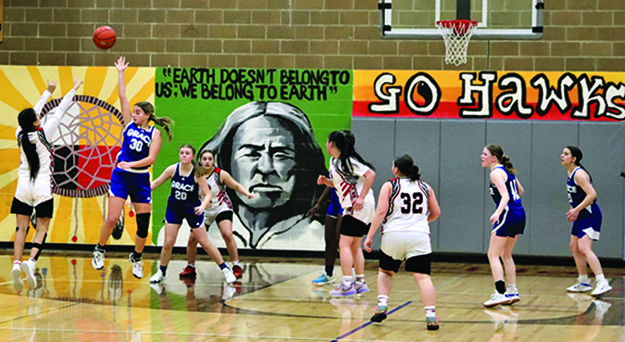
By Micheal Rios, Tulalip News
After narrowly losing to Orcas Island, 29-34, in a defensive battle in their opening game of the NW1B District playoffs, the Tulalip girls hosted their crosstown rival Grace Academy on Tuesday, February 6, in a loser-out game. In front of a horde of their devout fans, the Lady Hawks took to the Francy J. Sheldon gymnasium hardwood with full knowledge of the stakes: win and advance, lose and go home.
In their two regular season matchups, Tulalip bested Grace 33-27 and 41-29, which gave the home team a boost of confidence seeing the same opponent a third time. That confidence showed on Tulalip’s opening possession when Audrielle McLean splashed a 3-pointer on her first touch and gave her team a 3-0 lead. It showed when moments later Lilly Jefferson shot a midrange jumper that banked in. Those 5 early points would be all the Lady Hawks could muster for a long while though, as Grace implemented a 3-2 zone that stifled Tulalip’s perimeter-oriented offense.
Trailing 5-11 midway in the 2nd quarter, sophomore forward Raylee Lewis battled for an offensive rebound and was rewarded with a put-back bucket. The 5’5” Raylee again snatched a rebound away from Grace’s nearly 6-foot center, and put up a super quick layup off the glass before any defenders could contest. Her two buckets were the Lady Hawks only ones in the 2nd quarter.
Fast forward to early in the 3rd quarter, Tulalip trailed 11-25 and things began to look bleak. The transition game that the girls made their bread and butter on all season was nonexistent, and to make matters worse their senior guard Tieriana McLean was out for the remainder of the game with a wrist injury. They also had no answer for Grace’s center Candice Mugo who resembled Shaq with her dominating presence in the paint.

BUT, and it’s a big but, the beauty of sports is sometimes miracles happen. Epic comebacks. Catastrophic collapses. And whether or not any one thought they could actually come back against such undesirable circumstances, junior guard Audrielle did. At least her play conveyed that.
From late in the 3rd quarter to midway through the 4th, her teammates fought for every loose ball, did their best to corral every rebound and force turnovers, and each time they got another possession, they’d immediately look for Audrielle and pass her the ball. She turned into a true solo artist on offense. Splashing one deep 3-pointer after another. Each met with a louder and louder cheer from the home crowd. After her sixth made 3 ball, the Lady Hawks had clawed their way back to get within one possession of Grace, 28-30, with just under 2:00 left.
Comeback almost nearly complete, the Lady Hawks got a few quality looks in the games final seconds, but they would rim out. Grace would feed their post monster, who scored on their next two possessions, and that was a wrap. Tulalip lost on their home floor 28-35, ending their season.
Audrielle finished with 19 points, Raylee added 6 points, Lilly scored 2 points, and Isabelle score 1 point.
“This season was my first time ever playing basketball,” shared 15-year-old Raylee after the game. “I’ve got a lot of cousins on the team and they were the ones who convinced me to play. My coaches and teammates kept telling me how much I was improving practice after practice and game after game. Looking back at how far I’ve come from the beginning to now, it really did mean so much to play on this team and in front of so many fans from the community. I’m not known as a scorer, so with this being our last game, it was actually real exciting to get some buckets with my parents and grandparents in the stands.”
Hawks get gigantic W over Mt. Vernon Christian
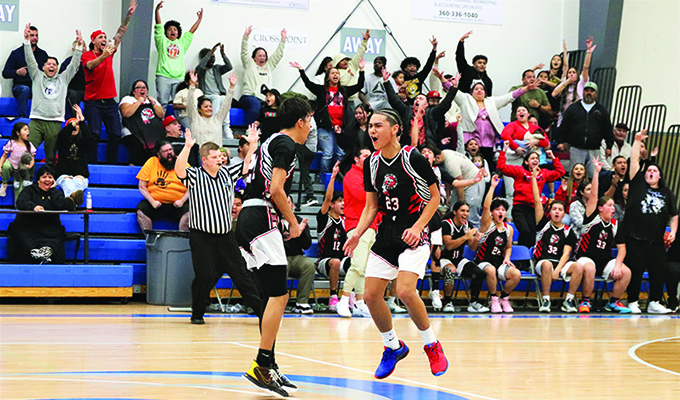
By Micheal Rios, Tulalip News
The Tulalip Hawks hit the road and travelled north for a matchup with the Hurricanes of Mt. Vernon Christian. A 3rd round game of Districts with a chance to play in the 1st/2nd place game, Tulalip’s adoring fans hit the road, too, and actually outnumbered the Hurricanes fans in their own building.
A tense atmosphere in the early going as both teams traded buckets to notch it at 7-7. With chants of “Defense!”, the boys turned up their defensive intensity and forced the Hurricanes to play out of their comfort zone. Tulalip got their transition game going and continued to force the tempo to run up a 28-21 lead at halftime.
Midway in the 3rd quarter, freshman guard J.J. Gray caught fire from deep and swished in three straight 3’s to push his team’s 43-31. With 3:00 in the 3rd quarter, the Hurricane’s called timeout to attempt to settle their team, but instead were met with a devastating chant of “Tulalip Power!” from the unrelenting visiting fans.
In the 4th quarter, the game tightened up and the usual shots for the Hawks weren’t falling. The Hurricanes finally started to execute their offense and flipped the turnover script by getting Tulalip to force errant pass after errant pass. The boys watched their 12 point lead vanish and were suddenly trailing 43-44 with three minutes to go.

Freshman guard Amare Hatch finally put an end to his team’s scoring drought by coming up with a steal and scoring a contested layup. Moments later he’d splash a 3 that put his team up for good, 48-45. Just for good measure, senior forward Hazen Shopbell, instead of holding the ball and waiting for the Hurricanes to foul him, opted to shoot a 3 of his own and join in on the long ball party. Fortunately, it went in to the delight and uproar of his teammates and all the Tulalip fans who knew the W was secured.
The Hawks 52-46 win means no less than 2nd place in Districts. They’ll again hit the road, this time for Lummi Nation, for a matchup with the Blackhawks on February 8.
Hawks soar over Concrete Lions

By Micheal Rios, Tulalip News
The Tulalip Heritage boys basketball team finished a hard fought regular season with a (12-6) record. Having won seven of their final eight games, the Hawks earned a high seed in the NW1B District playoffs and the right to host a playoff game.
On Saturday, February 3, family and friends lined the bleachers of Francy J. Sheldon gymnasium to cheer on their local teenage hoopers as they hosted the (7-14) Concrete Lions. This would be the third meeting between Tulalip and Concrete, with both getting a W on their home court previously.
It was a pressure-filled 1st quarter as the Hawks came out tight in the opening minutes of their first playoff game. Senior guard Chano Guzman did his best to set the tone offensively with his usual attacking style. He knocked down two 3-pointers and three middy’s to score 12 points in the 1st. With 2:15 to play in the 1st quarter, the score was tied 14-14. The Lions were able to keep pace by hitting 3-pointers of their own and capitalizing on their bigger front-line players securing offensive rebounds and put back buckets.

Concrete continued their overachieving play to take their first lead of the game 20-18 early in the 2nd quarter. It would be a super short-lived lead though as it seemed to spark Tulalip’s competitive fire. Fueled by their unrelenting pressure defensively, the boys forced Concrete into one turnover after another. Each seemingly leading to transition layup or high percentage shot. Six Hawks players scored down the stretch before halftime, then freshman guard J.J. Gray caught fire in the 2nd half.
After the Hawks went down 18-20 early in the 2nd quarter, they used stifling defense and a diverse offensive attack to go an incredible 38-8 run that spanned to late in the 3rd quarter. Now up big 56-28, head coach Shawn Sanchey used the comfortable lead to insert his bench to the cheer of the crowd.
Nearly every shot by a reserve player received a little roar of anticipation from the crowd and benched starters, who were more than eager to see their brethren get a playoff bucket. Final score was a whopping 72-49 win. The Hawks were led in scoring by J.J.’s 25 points and Chano’s 22 points, while seven of their teammates also got into the box score.

After the game, Coach Shawn shared his thoughts on the playoff W. “Having played Concrete twice before, we had a good idea on what we’d see from them and which areas we really needed to prioritize. The first two games, we weren’t at full strength either, so that was a benefit this time around knowing we were at full strength.
“It was impressive to see one of our senior leaders on the team, Chano, rise to the occasion early with his on-ball defense and timely buckets. He’s been a part of our Heritage program for a few years now and has the experience needed to keep our team together in tough moments and set the tone for us.”
Lastly, Coach Shawn added the significance of his starters taking control of the game and building the big lead so that their teammates could get some court time. “I tell the boys every game that they owe to the game and their team to work hard each quarter so the whole team gets a chance to play. Everyone, starters and bench players, works super hard and grinds every practice to get us here, so it’s only fair that we work hard in games like this to get our whole team some court time.”
February 3, 2024 syəcəb
Use the following link to download the February 3, 2024 issue of the syəcəb